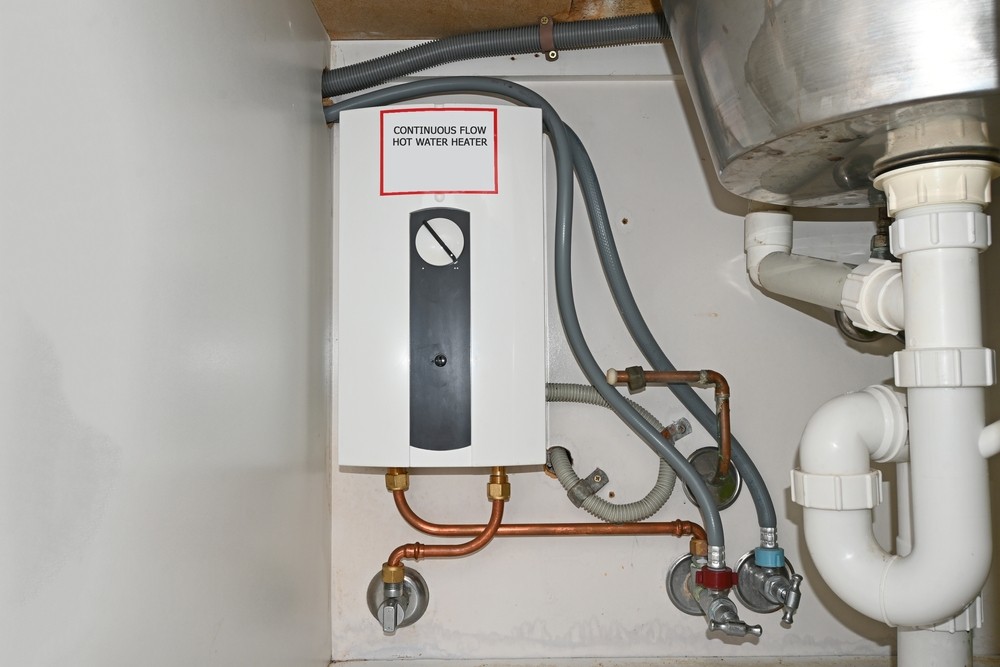Tankless water heaters have emerged as a popular alternative to traditional tank-style water heaters. With their promise of on-demand hot water, energy efficiency, and long-term cost savings, they offer an attractive option for homeowners looking to optimize both their home utility systems and their budget. While the initial cost might seem daunting, delving deeper into the long-term benefits clarifies why tankless water heaters can be a financially and environmentally prudent choice.
Understanding Tankless Water Heaters
Tankless water heaters, also known as on-demand or instantaneous water heaters, operate differently from traditional tank-based models. Instead of continuously heating a reservoir of stored water, they heat water only when it is needed.
When a hot water tap is turned on, cold water travels through a pipe into the unit, where either a gas burner or an electric heating element rapidly heats it. This eliminates the need for a storage tank, thereby reducing standby energy losses—a major drawback of conventional water heaters.
The Cost-Benefit Analysis
To truly understand the financial implications of investing in a tankless water heater, it’s essential to break down both the costs and benefits associated with these systems.
Initial Cost and Installation
The upfront cost of a tankless water heater is significantly higher than that of a traditional storage water heater. The price varies depending on:
- The type of heater (gas vs. electric)
- Capacity (the unit’s ability to supply hot water at peak demand)
- Brand and technology features (Wi-Fi controls, self-cleaning functions, energy ratings)
A high-quality tankless water heater typically costs between $500 and $2,500, whereas a conventional storage water heater ranges from $300 to $1,200.
However, installation costs can be higher for tankless models because they may require:
- Upgraded gas lines or venting systems (for gas-powered models)
- Electrical system modifications (for electric-powered models)
- Additional plumbing adjustments to accommodate the unit’s requirements
On average, installation costs for tankless water heaters range from $1,000 to $3,500, whereas traditional water heaters cost $600 to $1,500 to install.
Energy Efficiency and Monthly Savings
One of the primary reasons homeowners opt for tankless water heaters is their energy efficiency.
According to the U.S. Department of Energy:
- Homes that use 41 gallons or less of hot water daily can achieve 24%–34% greater energy efficiency with a tankless model.
- Homes using around 86 gallons per day can still see 8%–14% energy savings.
These savings stem from the elimination of standby heat loss, which occurs in traditional tank heaters that constantly maintain a reserve of hot water.
With reduced energy consumption, homeowners can expect lower utility bills. On average, tankless water heaters can reduce annual energy costs by $75–$300, depending on household size and usage patterns. Over 20 years, this can amount to $1,500–$6,000 in savings, effectively offsetting the initial purchase and installation costs.
Operational Costs and Maintenance
While tankless water heaters require less energy, they do require periodic maintenance to operate efficiently. Regular descaling and flushing are necessary to prevent mineral buildup, particularly in areas with hard water.
Common maintenance tasks include:
- Flushing the system (annually or biannually) to remove calcium deposits
- Checking the heating element or gas burner for efficiency
- Cleaning the in-line filter to ensure proper water flow
Though maintenance costs vary, they generally range from $75 to $200 per service, depending on whether it’s performed professionally or as a DIY task.
Lifespan and Replacement Costs
A traditional storage water heater typically lasts 10–15 years, whereas a tankless water heater can last 20 years or more with proper maintenance.
This extended lifespan means that homeowners with traditional water heaters may face multiple replacements over a 30-year period, whereas a single tankless unit could serve for decades. Given that storage water heaters cost $1,000–$2,500 per replacement, the longer lifespan of tankless units results in significant long-term savings.
Maximizing Savings with Optimal Usage
While the benefits of tankless water heaters are compelling, homeowners can further maximize efficiency and savings by implementing smart usage strategies.
1. Choosing the Right Size Unit
One of the most common mistakes homeowners make is selecting a tankless water heater that is too small or too large for their needs.
- Undersized units may struggle to supply sufficient hot water, leading to frustration.
- Oversized units may consume more energy than necessary, negating efficiency benefits.
To find the right unit, it’s important to calculate:
- Peak hot water demand (gallons per minute, GPM)
- Temperature rise needed (difference between incoming water temperature and desired output temperature)
A professional HVAC contractor or plumber can assess household demand and recommend the most efficient model.
2. Adjusting Temperature Settings
The U.S. Department of Energy recommends setting the water heater temperature to 120°F for optimal energy efficiency and safety.
3. Using Smart Hot Water Practices
- Showering back-to-back minimizes energy waste by keeping the system running efficiently.
- Insulating hot water pipes reduces heat loss and decreases the energy required to maintain water temperature.
- Using low-flow fixtures reduces overall water demand, improving efficiency.
Environmental Impact and Sustainability
Beyond cost savings, tankless water heaters align with sustainable living practices, making them an eco-friendly choice for environmentally conscious homeowners.
Reduced Carbon Footprint
Since tankless models consume less energy, they reduce overall greenhouse gas emissions, helping lower a household’s carbon footprint.
Less Material Waste
With their longer lifespan, tankless water heaters contribute less waste to landfills, reducing the environmental impact associated with manufacturing and disposal.
Water Conservation
Although tankless heaters do not inherently reduce water usage, they can encourage better habits by:
- Eliminating the need to let water run while waiting for it to heat
- Supporting point-of-use installation, reducing wasted energy in long piping runs
Additional Considerations Before Switching
Before investing in a tankless water heater, homeowners should evaluate:
- Climate and Incoming Water Temperature – In colder climates, the greater temperature rise required may necessitate a more powerful unit.
- Energy Source Availability – Homes with existing gas lines often find gas tankless models more cost-effective, while homes without gas access may need electric models.
- Rebates and Incentives – Many utility companies and government programs offer rebates for energy-efficient water heaters, reducing upfront costs.
Investing in a tankless water heater represents more than just a technological upgrade—it’s a strategic decision that balances cost savings, energy efficiency, and sustainability.
While initial costs may be higher, the long-term benefits—including lower energy bills, a longer lifespan, and a reduced carbon footprint—make tankless systems a compelling choice.
For homeowners looking to future-proof their homes against rising energy costs while also reducing environmental impact, tankless water heaters offer a practical and financially sound solution.



